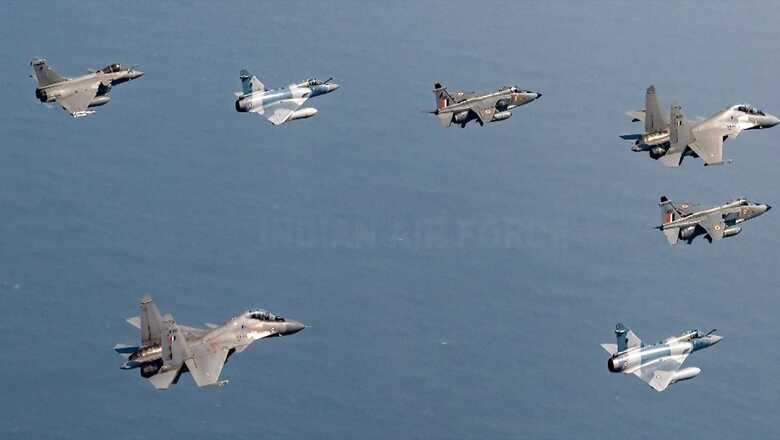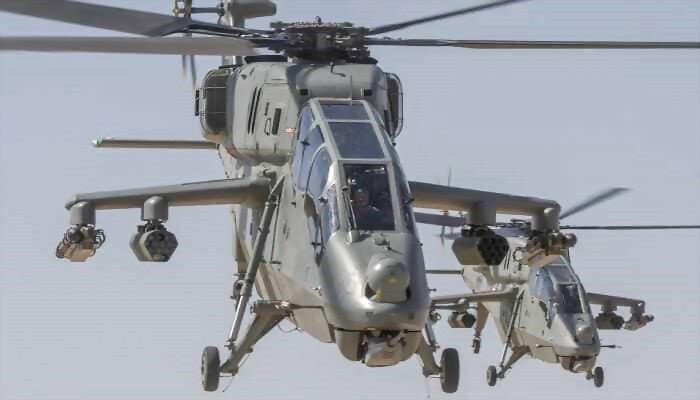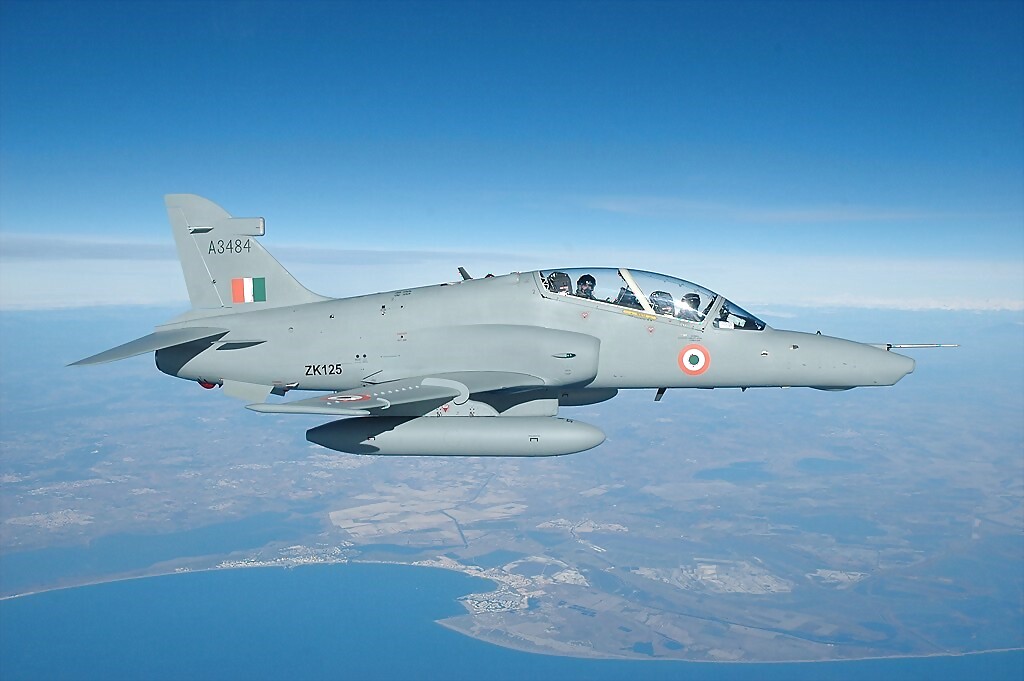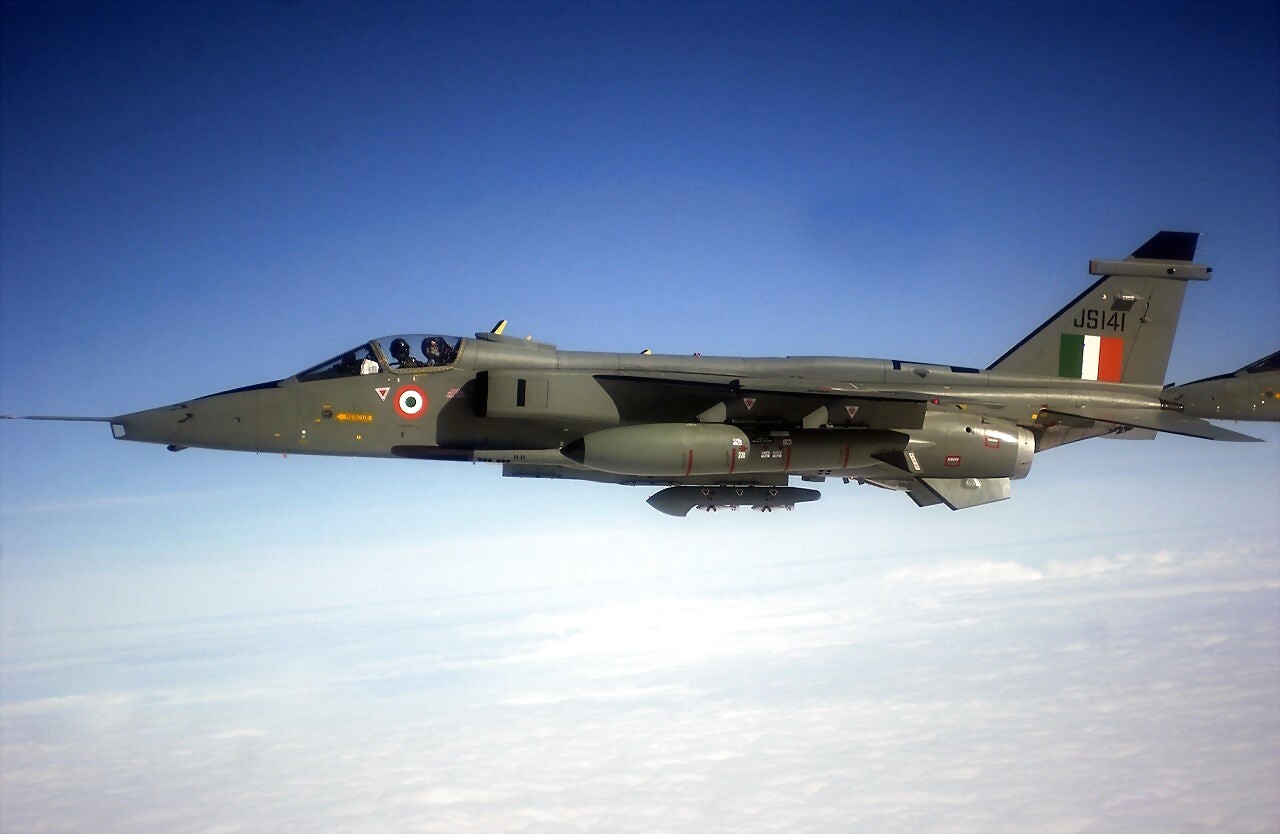
views
At the time of independence, Indian Air Force (IAF) inherited some of the aviation assets left by the British including Hawker Tempest and Spitfires. India also procured British aircraft like the Hawker Hunter, the Gnat, Devon and Vickers Viscount. The United States of America was reluctant but offered some helicopters. The French offered fighter aircraft in the 1950s such as Dassault Ouragan (Toofani) and Mystere. By the late 1950s, India had inducted Soviet medium transport aircraft IL-14 and Mi-4 helicopters and in the 1960s, Antonov An-12 and a top-line MiG-21 fighter. India also procured many Soviet air defence systems and weapons. With this began a relationship of ‘Bear Hug’ that even today, nearly 65 percent of the IAF aircraft fleet is of Soviet/Russian origin. Hindustan Aeronautics Limited (HAL) also initially began manufacturing foreign aircraft under license production, including the French Allouette, British Gnat, Russian MiG series, and Jaguars among many others. Sourcing from different countries had its own complexities of mixed spare inventories and overhaul management. This sometimes resulted in lower aircraft serviceability and higher maintenance cost. Also, in many cases, the Life Cycle costs went up.

Current Fighter Fleets
The Anglo-French fleet of the Sepecat Jaguar aircraft was ordered in 1978 and large numbers were built by HAL under license. India made major avionics updates including the inertial attack system (DARIN), autopilot, cockpit avionics, weapons and radar. The IAF still has significant numbers and plans to operate till 2030. It operates 36 French Dassault Rafale. It had earlier bought Dassault Mirage-2000 in 1984 and the same has been upgraded to Mirage-2000-5 Mk II standards. Mirages will fly in the IAF beyond 2030. HAL carries out Mirage aircraft and engine overhauls. Most components and spares still come from abroad. Many of the MiG-29s procured from the Soviet Union have been upgraded recently. The last three upgraded MiG-21 ‘Bison’ aircraft are still with the IAF and will phase out by 2025. It acquired a large fleet of Sukhoi SU-30MKI, most of which have been license-produced in India. The aircraft will soon be upgraded as ‘Super Sukhoi’ with active electronically scanned array (AESA) radar and will be the backbone of IAF’s fighter fleet for at least the next two decades.
Transport Aircraft
Over 80 British Hawker Siddley HS-748 medium turboprop aircraft were license-produced in India by HAL. A few of these aircraft are still used for communication duties. HAL built the German Aviation ‘Dornier 228’ under license in India. The IAF operates the Russian Ilyushin IL-76MD (freighter), IL-78MKI (flight air refueller), and A-50 with Israeli Phalcon radar as AEW&C. The IAF has over 100 AN-32s, which came from a plant in Ukraine. Meanwhile, Indo-US relations have come a long way since the cold vibes of the 1950s which had pushed India into the Soviet camp. From 2004, the Indo-US Cope India series of joint exercises began and the IAF also participated in the Top-Gun Red Flag Exercises in the US. India procured the Boeing P-8I for the Indian Navy, Lockheed C-130J-30s ‘Super” Hercules’, and Boeing C-17 Globemaster III, strategic lift aircraft for the IAF. The nation has recently signed a contract with Airbus for 56 CASA C 295 W, 40 of which will be built in India.

Helicopters
Over 300 Aerospatiale Allouette III, light utility helicopters were manufactured under license by HAL. Variants ‘Chetak’, ‘Cheetah’ and ‘Cheetal’ are still flying in India, including for high-altitude operations in the Siachen glacier. Mid-sized Russian utility and assault helicopters Mi-8s joined the IAF in the early 1980s. Later, more advanced versions such as the Mi-17, Mi-17-1V and Mi-17V-5s followed. Very large numbers are still in service. The IAF procured Boeing Apache AH-64 Longbow attack helicopters and CH-47 Chinook heavy-lift helicopters. The US has thus gotten into India’s transport and helicopter ecosystem. They are now offering the F-16, F-18 and F15 for the MRCA completion.

Trainer Aircraft
HAL Kiran (HJT-16), the intermediate-stage jet trainer, was influenced by the British ‘Jet Provost’ design. Kirans have the Rolls Royce Viper engine and later versions Bristol Siddeley Orpheus engine. India acquired nearly 75 Swiss Pilatus PC-7 Mk II trainers. BAE Systems Hawk Mk 132, a British single-engine advanced jet trainer is used for training and low-cost combat. These are being built by HAL under license.
Unmanned Aerial Vehicles
Israel has been a very significant aerospace partner of India since the two established formal diplomatic relations in 1992 and defence ties in 1996. India acquired Heron and Searcher Unmanned Aerial Vehicles (UAV) and Harpy and Harop Combat UAVs (UCAV) from Israel. India is dependent on Israel for many radars and missile systems, and avionics. India is also likely to acquire 30 MQ-9 UAVs for the three armed forces from General Atomics Aeronautical Systems, Inc. (GA-ASI) of the US, two of which have been on lease with the Indian Navy for two years. Meanwhile, India has an ambitious plan for indigenous UAVs and drones.
Aircraft Engines
India has been dependent on foreign-origin aircraft engines. The nation has been making Russian, British and French engines under licence for many years. Even the ALH engine Shakti is through a joint venture with France. The US-origin General Electric engines power LCA variants and are likely to be used for Advanced Medium Combat Aircraft (AMCA) for time to come.

HAL, PSUs and Private Industry
HAL has made thousands of fixed and rotary-wing aircraft in the last 75 years. Other than HF-24 Marut, ALH helicopter variants, a few trainers, and more recently the LCA, all aircraft have been of foreign origin, license-produced in India. HAL built aircraft using foreign production technology drawings. In most of these cases, India has been dependent on foreign suppliers even for relatively low-end technologies. Often, license-production was at the mercy of foreign-supplied systems or parts. At times, small parts become obsolete because no one manufactures them due to poor economies of scale. HAL did succeed in creating local vendors for these parts. Even today, many major components of LCA, the engine, radar, ejection seat, many avionics and weapons are imported.
The logistics chain for the IAF often means routing spare parts from foreign vendors through HAL. Its ability to arm-twist foreign vendors is relatively low. Also, many foreign suppliers are worried of India becoming independent of them and keep delaying supplies to HAL intentionally.
India has successfully used the joint-venture route in some cases, but there has been no significant transfer-of-technology (ToT) in most cases. China has used intellectual theft and reverse engineering to build top-end defence systems, but has now invested large sums in research and development and has become independent.
Indian private aviation industry is also dependent on many DRDO labs and other Defence PSUs, who in turn are dependent on foreign firms. Complexities for private players are similar. The Drone Federation of India has listed many critical components of drones made in India that are still imported. While it is encouraging to see some major private players entering defence production, the industry still needs hand-holding and support with India-friendly policies and it is presumed that the new Defence Acquisition Procedure will make a difference.
Logistics and Maintenance Complexities of Multi-Country Fleets
From the above, it is clear that India is dependent on many countries. Managing aircraft fleets from many countries has its complexities. Each country follows different methods of inventory management and in many cases, India has to follow a similar system. Each country has different import and export regulations and follows different customs procedures. There are different timelines for repairs and spare supplies. Each country has different agencies to deal with and many have further placed orders to sub-vendors.
Many unpredictable trigger events bring in logistic chain disruptions. The break-up of the Soviet Union in the early 1990s caused a level of turmoil for supplies. Though Russia took over the contracts and supplies, India still had to deal with other countries like Ukraine for many items. Similarly, with the recent Russia-Ukraine conflict, there has been a disruption of some supplies. Russia’s own internal arms replacement requirements due to the war has brought in their own supply priorities. When India became a nuclear weapons power, many countries led by the US had put arms supply restrictions. Luckily, Russia and France stood by India then.
A few Western countries like the US do have strategic or political reasons for military supplies but most of the European countries primarily have commercial interests. The Soviets, to politically win over India, earlier supplied aircraft in barters for ships loads of bananas, shoes or hosiery. After the breakup in 1991, the payments began in hard dollars but the mindset of many, in the Russian aircraft industry, has to still recover from the Soviet hangover. Even the signing of small contracts for spares takes a long time with Russia. Some Russian production houses are financially weak because of considerably reduced orders.
Post-Ukraine conflict, it is clear that supply chains can be disrupted through financial and shipping-related sanctions. One of India’s submarines on repair in Russia cannot be back due to such sanctions.
The initial per unit cost of the Russian combat aircraft has always been lower, but the Life Cycle Costs (LCC) have invariably been high because of faster replacement rates and shorter overhaul cycles. Because of the long repair cycle involving complex export-import procedures, the Russian fleet serviceability has often been seen between 50-60 percent. While the Western countries have adopted modern online means of spare monitoring and supply, the Russians mostly follow the old system of indenting. Serviceability rates of some Western fleets have been relatively higher. Any force with around 650 combat aircraft having 60 percent serviceability would mean 260 aircraft in the hangar. The government-mandated serviceability is stipulated at 75 percent. Taking the cost of a typical fighter even at around Rs 400 crore, nearly 260 aircraft on the ground would mean assets worth Rs 1,04,000 crore being non-operational.
Balancing the Arms Basket
Undoubtedly, the Soviet Union and Russia were a great help to India for arms supplies during critical initial years and the relationship remained rock-solid. However, after the 1990s, Western countries pushed ahead in some technologies. Also, as India started becoming a significant economic and military power, the West began to woo it and was more ready to give advanced weapons. This gave India greater options to choose from. In the long term, it is not in India’s interest to have most of its eggs (arms) in a single basket.
India has to thin its Russian aircraft basket. The nation finally backed out of the joint Fifth Generation Fighter Aircraft (FGFA) program with Russia, ostensibly for technical reasons. It also did not pursue the twin-engine Multirole Transport Aircraft (MTA), and the Ka-226 light utility helicopter. The IAF, which at the peak had nearly 85 percent Russian aircraft, has already come down to around 65 percent. Yet, just the Su-30 MKI constitute nearly 40 percent of the IAF’s fighter fleet. The arms basket needs balancing.

Operational Management of Multiple Fleets
The IAF has airborne platforms from Russia, the US, the UK, France, Israel, Ukraine and Switzerland. India has seven types of fighters in Su-30 MKI, Rafale, Mig-29, MiG-21 Bison, Mirage 2000, Jaguar, and LCA Tejas. Clearly, the IAF had no choice but to master the art of operationally managing mixed fleets. India has also managed to integrate a large number of fully programmable Western and Indian avionics even in the Russian aircraft, which do have some commonality of systems with each other, but spare part nomenclatures being different did make it difficult for the IAF to manage inventories for some years. In the initial years, the combat employment approach of the IAF was Russia-centric, but after the induction of the Jaguar and Mirage-2000, the same changed and also the Tactics and Air Combat Development Establishment (TACDE) supported the evolution of the Indian combat employment approach.
Action Time
IAF’s depleted air assets have to go up for an air campaign in a two-front scenario. Technology-intensive air power requires faster replacement of assets due to quicker obsolescence. The IAF is down to 30 combat Squadrons vis-à-vis the authorised 42. Low serviceability adds to the already dismal scenario. A critical component of improved serviceability is the improved logistics chain. Many fleets mean many aircraft inventories. Every 5 percent improvement in serviceability would mean adding 32 aircraft (1.5 squadrons). Serviceability is also linked to supply chains.
The Pakistan Air Force (PAF) has decided to restrict its fighter aircraft fleet to just 3-4 types in the long run. These would primarily be the F-16, J-10C and JF-17. China is also working towards that end. In the long run, India must start rationalising its fleets. I feel India should primarily have the AMCA, LCA, Su-30 MKI and one more foreign fighter type, bringing down the fleets to just four. The MiG 21 Bison will phase out and the LCA Mk2 will replace the Mirage-2000, Jaguar, and MiG-29. India will have to buy a foreign MRCA. The IAF already has two squadrons of Rafale. It has already paid for India-specific enhancements, two air bases have the infrastructure to take on more aircraft and if the Indian Navy decides to shortlist Rafale-M for carrier operations, it would then make eminent sense to go for more Rafale aircraft, making it much more viable to Make-in-India.
Rationalising and reducing the number of fleets should be a priority. Till we induct more indigenous aircraft, all future procurements must keep this factor in mind. Geo-politically, it is best to spread eggs in different baskets. In the long run, India must initially target what I call the 30-30-40 aircraft mix. This means 30 percent Russian, 30 percent Western and 40 percent Indian. It may take us over two decades to reach there, but it should be the target.
The writer is Director General, Centre for Air Power Studies. The views expressed in this article are those of the author and do not represent the stand of this publication.
Read all the Latest Opinions here
















Comments
0 comment